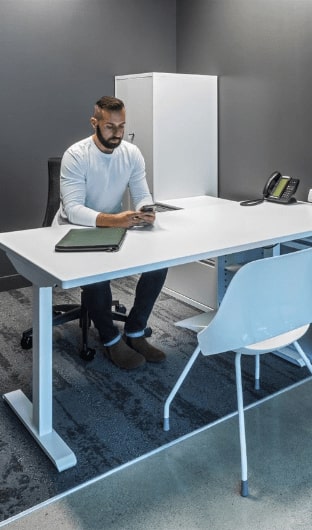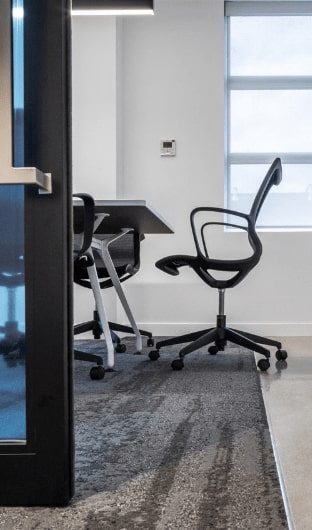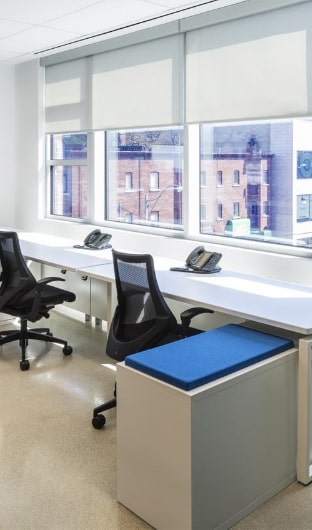
Designing For A Multigenerational Workforce
Today’s workplaces look different than they have in the past. Not only are we seeing an increase in the number of remote and hybrid workers, but for the first time in history, workspaces must accommodate four generations at once: Baby Boomers, Gen X, Millennials, and Gen Z. While this may not seem to be an issue on the surface, it can actually cause challenges in the workplace.
Each generation has their own set of values, preferences, and expectations when it comes to working. How do you design a space that suits the requirements of all four of these different generations?
Generational Differences
First, it is important to understand the differences between the generations. When you understand what motivates your employees and what they expect from their employer, you can work towards creating a space that accommodates these needs.
Currently, millennials make up the majority of the workforce—approximately one third—and this majority will continue in upcoming years. As such, it is important to understand this segment of your workforce. For millennials, the experience they have at their workplace is important, and experiential features that promote a positive workplace experience should be reflected in their work environment. They want to build a connection with their workplace as well as with their co-workers, and collaboration and teamwork are important to them.
Gen Z, on the other hand, prefers to work alone, with meetings and other communication held virtually rather than face-to-face. This generation is also passionate about sustainability and social justice, so they need to see similar values demonstrated by their employers. An eco-friendly workspace, or one that is committed to social causes, will be attractive to this youngest generation.
Often called the forgotten generation, Gen X prioritizes convenience in their workplace. When possible, they will choose to work somewhere proximate to their home, gym, children’s school, or other daily amenities. They will be less likely to be interested in office activities or social gatherings than their younger counterparts, preferring to keep their time at the office focused on their work.
Similarly, Baby Boomers have more traditional work values, and like to keep their professional and personal lives separate. They prefer familiarity and routine, and often prefer to work in-office as opposed to remotely. Baby Boomers will gravitate towards workspaces that are more static in nature, where they have their own dedicated space, with the ability to leave their work behind at quitting time.
Contrarily, both Millennials and Gen Z prefer to work remotely, rather than in-office, and view the office as a space for collaborating and socializing. They believe that solo work can be better performed elsewhere: in their home office, at a co-working space, or in their local coffee shop, for example.
It may seem that these generations are destined to be working at odds, constantly butting heads when it comes to where and how the workplace is designed. However, in a properly planned office space that takes advantage of, rather than ignores, their differences, these generations will be able to come together and work harmoniously and effectively.
Continue reading to learn more about how you can design a space that will please a multigenerational workforce, allowing you to increase employee satisfaction and retention in the long term.
Functionality
First, it is important that spaces are designed for functionality, allowing employees of all generations to do their jobs effectively throughout the day. Employee tasks and company culture will have an effect on how a space is designed. Speak to your employees for feedback on what they need to do day-to-day, what features would improve their performance, and what the types of spaces they prefer to work in are. Ensure to consult employees from different generations to see where their values and preferences overlap, and where they diverge.
Consulting your employees will not only help them to feel more valued but will also allow them to feel a greater connection with your business, as they will be able to feel that they have made a meaningful contribution to their workplace. This is especially important for the relationship-valuing Millennial generation. Once you have surveyed staff and tackled the main workspaces, you will be able to add additional features that cater to different cohorts of employees. Perhaps a section contained workstations for private Gen Z and Baby Boomer employees, or a social lounge area for collaborative Millennials.
Flexible Design
While it is important that a space’s functionality is at the forefront of its design, flexibility should also be a driving factor in your choice of furnishings. In order to accommodate all generations, the ability to reconfigure, modify, and quickly customize spaces to suit a variety of needs is paramount. To this end, modular furniture can be effectively incorporated throughout your design.
Modular furniture allows you to easily customize a space to your needs, as furniture pieces are comprised of smaller, moveable sections in a variety of shapes and sizes. If employees want to collaborate, they can quickly move a set of desks together into a meeting table. If they would like to work independently, common lounge seating can be reconfigured into private seating areas. By incorporating modular furniture, your workplace can provide employees with a variety of working areas, giving employees more control over their working environment.
Finally, allow employees to choose how and where they want to work in order to keep all generations happy. This includes allowing them to work remotely! By providing flexibility, employees can feel they have more autonomy and freedom, allowing them to work in a space that suits their daily needs and mood. Allowing this flexibility will improve overall employee satisfaction, allowing you to better retail employees of all generations.
Find Common Ground
It can be easy to focus only on the differences between the generations, quickly becoming discouraged at the prospect of designing for a variety of preferences. Instead, focus on finding common ground between all your employees! Design a workplace that not only can accommodate employees while also being comfortable and productive, but that can foster connections between the employees themselves.
Personal connections are valued by all generations, and encouraging bonds between employees can help them not only better understand each other, but also work more productively together. Highlight the knowledge and experience of your employees by implementing mentorship programs, or their skills through skill-sharing workshops or seminars. Showcase your employees to each other, allow them to get to know each other, and form personal connections that span the differences between generations.
It is important to communicate regularly with your employees to determine how they feel about your workplace and ensure they are satisfied. No matter their generation, ensure employees understand the intended functionality of newly designed spaces, avoiding potential anxiety and conflict over mixed expectations of how spaces should be used. Encourage employees to communicate with you and with each other to overcome hurdles that may be encountered within the workspace.
If you are feeling overwhelmed designing a space for a multigenerational workforce, the experts at Harkel Office are here to help. With up-to-date knowledge of design trends, extensive experience creating custom spaces, and familiarity with modern products such as modular furniture, Harkel Office can help take the stress out of designing your new space. When you work with Harkel Office, you can be confident that you will Get It Right. For a consultation, contact us at 905.417.5335 today.





